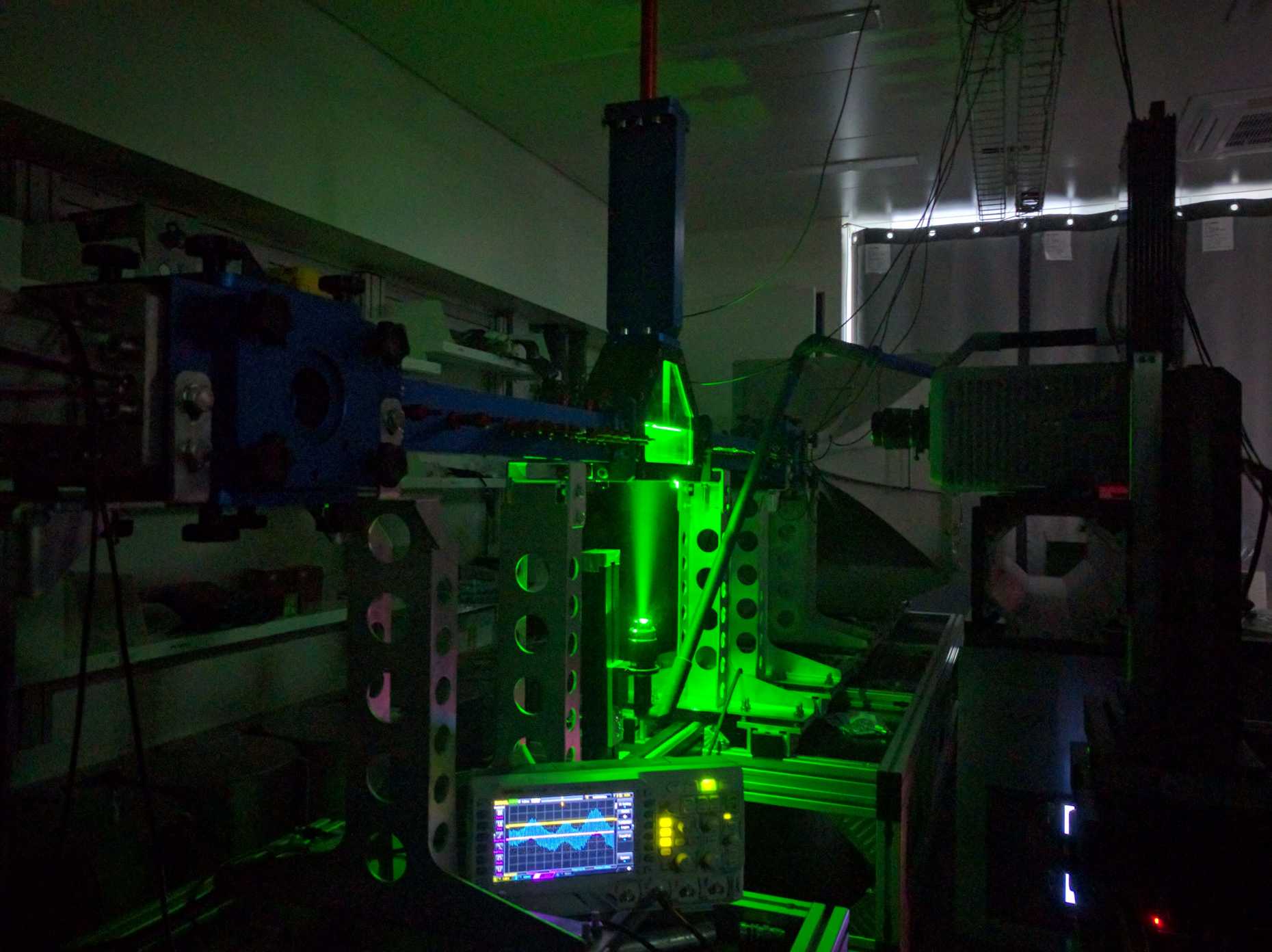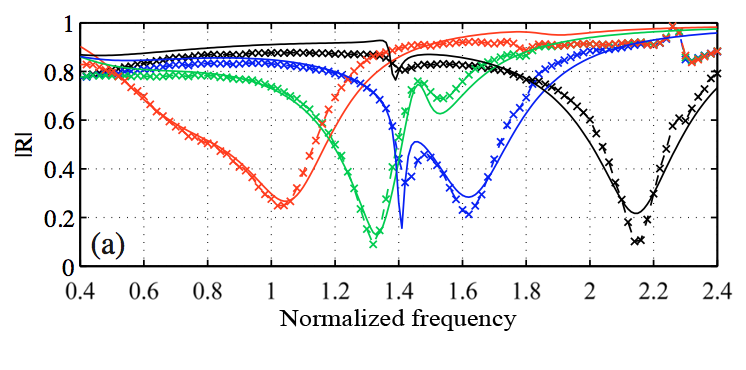Acoustics and Flow Physics
This theoretical, experimental and numerical research focuses on acoustic and aeroacoustic problems in fundamental and applied configurations.
We are particularly interested by the mechanisms of tonal and broadband noise generation induced by aeroacoustic couplings in turbulent internal and open flows. We work on acoustic technologies for eliminating noise pollution and noise-induced vibrations, as well as on acoustic metamaterials for manipulating (transmitting, reflecting, trapping, amplifying) sound waves in new engineering applications.
The development of these innovative acoustic damping systems and metamaterials is based on the long-standing expertise of CAPS in modelling and control of acoustic phenomena. Our experiments include acoustic field reconstruction using arrays of microphones and piezo sensors, high-speed particle image velocimetry, background oriented Schlieren thermometry, and our modeling approaches cover a large spectrum, from analytical methods with low-order models for wave propagation phenomena to Helmholtz and Large-Eddy-Simulation solvers.

Publications

Nonlinear dynamics of an acoustically compact orifice
K. Stoychev and N. Noiray
Journal of Sound and Vibration, Vol. 593, 2024
This work presents a three dimensional, low order model for the dynamics of an acoustically compact orifice, subject to an arbitrary pressure forcing, and validates it against DNS simulations and experimental measurements. […]


Synchronization under saturable nonlinearity
K. Stoychev, T. Pedergnana and N. Noiray
Chaos, Vol. 34, 2024
This theoretical work introduces a nonlinear gain saturation law representative of the experimentally observed properties manifested by phenomena ranging from aeroacoustic shear layers in self-sustained cavity oscillations to active laser media in photonics. […]


Nonlinear acoustics of an aperture under grazing flow
K. Stoychev, T. Pedergnana and N. Noiray
Royal Society of London. Proceedings A, Vol. 480, 2024
This work presents a mathematical model of a nonlinear, dynamically forced and acoustically compact aperture subject to one-sided mean grazing flow in two and three dimensions. […]


Self-sustained azimuthal aeroacoustic modes. Part 1. Symmetry breaking of the mean flow by spinning waves
A. Faure-Beaulieu, Y. Xiong, T. Pedergnana, and N. Noiray
Journal of Fluid Mechanics, Vol. 971, 2023
We study the aeroacoustic instability which occurs in a deep axisymmetric cavity in a turbulent pipe flow. The whistling of such axisymmetric cavity originates from the interaction of the coherent fluctuations of the vorticity at the cavity's opening with one of its trapped azimuthal or radial acoustic modes. We focus here on the situation involving the first pure azimuthal mode. […]


Self-sustained azimuthal aeroacoustic modes. Part 2. Effect of a swirling mean flow on the modal dynamics
A. Faure-Beaulieu, T. Pedergnana, and N. Noiray
Journal of Fluid Mechanics, Vol. 971, 2023
The whistling induced by a low-Mach turbulent flow through a deep axisymmetric cavity in a duct is investigated theoretically and experimentally. The experiments include acoustic measurements and stereoscopic particle image velocimetry (PIV). The paper focuses on the effect of a mean swirl on the dynamics of the azimuthal aeroacoustic modes. The mean swirl in the cavity has two origins: one component is imposed by a controlled tangential air injection upstream of the cavity, and the other component spontaneously arises under the action of the self-sustained azimuthal aeroacoustic mode. [...]
external page View at publisher


Exact potentials in multivariate Langevin equations
T. Pedergnana and N. Noiray
Chaos, Vol. 32, 2022
Systems governed by a multivariate Langevin equation featuring an exact potential exhibit straightforward dynamics but are often difficult to recognize because, after a general coordinate change, the gradient flow becomes obscured by the Jacobian matrix of the mapping. In this work, a detailed analysis of the transformation rules for Langevin equations under general nonlinear mappings is presented. We show how to identify systems with exact potentials by understanding their differential-geometric properties. [...]


Jetting axial flow induced by nanosecond repetitively pulsed discharges in quiescent ambient air
S. A Shcherbanev, T. Krzymuski, Y. Xiong and N. Noiray
Journal of Physics D: Applied Physics, Vol. 55, 2022
This study investigates the phenomenon of jetting axial flow induced by nanosecond repetitively pulsed discharges (NRPD) in quiescent ambient air in a pin-to-pin electrode configuration. Axial stratification of discharge parameters (electron number density, temperature, specific energy, etc) influences the hydrodynamic effects leading to directed gas flow from the cathode towards the anode. The experimental results presented in this paper were obtained using schlieren imaging, optical emission spectroscopy (OES), and electrical measurements of the deposited energy.


Modeling the nonlinear aeroacoustic response of a harmonically forced side branch aperture under turbulent grazing flow
T. Pedergnana, C. Bourquard, A. Faure-Beaulieu and Nicolas Noiray
Phys. Rev. Fluids, Vol. 6, 2021
Two physics-based models are derived to describe the nonlinear aeroacoustic response of a side branch aperture under turbulent grazing flow. After calibration, the models quantitatively capture the saturation of the acoustic gain from the mean flow, which is responsible for limit cycles arising from flow-excited aeroacoustic instabilities. The models are validated against experimental results.


Experiments on sound reflection and production by choked nozzle flows subject to acoustic and entropy waves
M. Weilenmann and N. Noiray
Journal of Sound and Vibration, Vol. 492, 2021
The acceleration of entropy waves in the turbine stages of aero-engines and gas turbines produces sound, which can contribute to the feedback mechanism of thermoacoustic instabilities. These instabilities cause high cycle fatigue of the combustor components, which may lead to catastrophic engine failure. This work deals with the challenging problem of experimentally quantifying entropy-wave-induced sound production from nozzles under choked flow conditions, at frequencies and turbulence intensities that are relevant for practical applications. [...]


Whistling of deep cavities subject to turbulent grazing flow: intermittently unstable aeroacoustic feedback
C. Bourquard, A. Faure-Beaulieu, N. Noiray
Journal of Fluid Mechanics, Vol. 909, 2020
In this work, the classic problem of the aeroacoustic instability occurring in deep cavities subject to a low-Mach grazing flow is revisited experimentally and theoretically. This instability is caused by the constructive feedback between the acoustic modes of the cavity and the turbulent shear layer that forms at its opening. Systematic experiments are performed in order to construct a new theoretical model, which describes the aeroacoustic system as two linearly stable oscillators, with linear reactive coupling, nonlinear damping and nonlinear resistive coupling. [...]


On the dispersion of entropy waves in turbulent flows
M. Weilenmann, Y. Xiong and N. Noiray
Journal of Fluid Mechanics, Vol. 903, 2020
Predicting and controlling entropy-wave-driven combustion instabilities is challenging, because the production, advection and dispersion of entropy waves in practical systems is difficult to model. The present paper aims to shed new light on this problem by considering a highly turbulent configuration with experiments and large eddy simulations. [...]


Towards robust BOS measurements for axisymmetric flows
Y. Xiong, T. Kaufmann and N. Noiray
Experiments in Fluids, Vol. 61, 2020
Accurately reconstructing a radial refractive index (n) field is challenging in axisymmetric background oriented Schlieren (BOS) measurement. In this study, we systematically investigated several widely adopted inversion algorithms in BOS applications. To quantitatively assess the performance of each algorithm, a synthetic experiment mimicking a helium jet discharged into ambient air was established to provide the reference. [...]


Analysis and reduction of spurious displacements in high-framing-rate background-oriented Schlieren
Y. Xiong, M. Weilenmann and N. Noiray
Experiments in Fluids, Vol. 61, 2020
Spurious displacements (SDs) associated with high-framing-rate background-oriented Schlieren (BOS) measurements were investigated experimentally in this study. To obtain the SDs, a multiple-pass cross-correlation algorithm was applied to reference/data images on a background printed with random dot pattern. [...]


Processing time-series of randomly forced self-oscillators: The example of beer bottle whistling
E. Boujo, C. Bourquard, Y. Xiong, N. Noiray
Journal of Sound and Vibration, Vol. 464, 2020
We present a model-based, output-only parameter identification method for self-sustained oscillators forced by dynamic noise, which we illustrate experimentally with a simple aeroacoustic setup: a turbulent jet impinging a beer bottle and producing a distinct whistling tone in a finite range of jet angles and jet velocities. Given a low-order model of the system, the identification is based on analyzing stationary time series of a single key observable: the acoustic pressure fluctuations inside the bottle. [...]

Comment on “Slow passage through resonance”
C. Bourquard and N. Noiray
Physical Review E, Vol. 100, 2019


Stability and limit cycles of a nonlinear damper acting on a linearly unstable thermoacoustic mode
C. Bourquard and N. Noiray
Journal of Engineering for Gas Turbines and Power, Vol. 141, 2019
The resonant coupling between flames and acoustics is a growing issue for gas turbine manufacturers, which can be reduced by adding acoustic dampers on the combustion chamber walls. Nonetheless, if the engine is operated out of the stable window, the damper is exposed to high-amplitude acoustic levels, which trigger unwanted nonlinear effects. This work provides an overview of the dynamics of this coupled system using a simple analytical model, where a perfectly tuned damper is coupled to the combustion chamber. [...]


Stabilization of acoustic modes using Helmholtz and Quarter-Wave resonators tuned at exceptional points
C. Bourquard, N. Noiray
Journal of Sound and Vibration, Vol. 445, 2019
Acoustic dampers are efficient and cost-effective means for suppressing thermoacoustic instabilities in combustion chambers. However, their design and the choice of their purging air mass flow is a challenging task, when one aims at ensuring thermoacoustic stability after their implementation. In the present experimental and theoretical study, Helmholtz (HH) and Quarter-Wave (QW) dampers are considered. [...]


Saturation of a turbulent mixing layer over a cavity: response to harmonic forcing around mean flows
E. Boujo, M. Bauerheim, N. Noiray
Journal of Fluid Mechanics, Vol. 853, 2018
Turbulent mixing layers over cavities can couple with acoustic waves and lead to undesired oscillations. To understand the nonlinear aspects of this phenomenon, a turbulent mixing layer over a deep cavity is considered and its response to harmonic forcing is analysed with large-eddy simulations (LES) and linearised Navier–Stokes equations (LNSE). [...]



